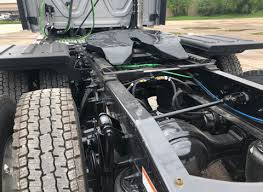сеп. . 04, 2024 06:38 Back to list
fifth wheel coupling mechanism
Understanding the Fifth Wheel Coupling Mechanism
The fifth wheel coupling mechanism is a crucial component in the field of transportation, particularly in the context of heavy vehicles such as trucks and trailers. This sophisticated hitching system serves as the connection point between a tractor and a trailer, allowing for a safe and efficient transfer of forces during movement. Understanding the fifth wheel coupling mechanism involves exploring its design, functionality, advantages, and applications.
At its core, the fifth wheel mechanism is designed to facilitate the coupling of a tractor unit to a trailer. It consists of a circular plate mounted on the tractor's chassis and a kingpin attached to the trailer. The kingpin fits into a slot in the fifth wheel, creating a pivot point that allows the trailer to articulate with the tractor. This articulation is vital for maneuverability, particularly when navigating tight turns or uneven terrains.
One of the primary advantages of the fifth wheel coupling mechanism is its ability to handle heavy loads. The design minimizes the stress on the towing vehicle, distributing the weight more evenly and thus enhancing stability while driving. This is particularly important for long-haul trucking and transporting goods over significant distances. The fifth wheel coupling mechanism allows for a weight capacity often in excess of 80,000 pounds, accommodating various cargo types efficiently.
Moreover, the fifth wheel coupling mechanism enhances the safety of transporting heavy loads. Its robust construction and design prevent the disconnecting of the trailer while in motion, a significant risk with less stable coupling mechanisms. Additionally, the fifth wheel includes features such as locking and latch systems that provide an extra layer of security, ensuring a firm connection between the tractor and the trailer.
fifth wheel coupling mechanism

In terms of functionality, the fifth wheel mechanism offers a level of flexibility that is absent in other towing systems. Its swivel action allows the trailer to pivot around the connection point, which aids in navigating corners without placing excessive strain on either the tractor or trailer. This is particularly advantageous in urban environments or construction sites where maneuverability is limited.
The fifth wheel coupling mechanism is predominantly used in commercial trucking, but its applications extend to recreational vehicles (RVs), where it provides stability and ease of use for larger trailers. Furthermore, it is used in other sectors such as agriculture, where agricultural trailers need to be securely attached to tractors for transport.
Maintenance of the fifth wheel coupling is essential for operational safety. Regular inspections can help identify wear and tear on the mechanism, ensuring that it remains in optimal condition. Operators are encouraged to grease the moving parts and check for any signs of damage or corrosion as part of routine maintenance.
In conclusion, the fifth wheel coupling mechanism plays an indispensable role in the safe and efficient operation of heavy-duty vehicles. Its design enables heavy load handling, provides enhanced safety features, and allows for remarkable maneuverability. As the trucking industry continues to evolve, the importance of reliable coupling mechanisms like the fifth wheel will only grow, ensuring the safe transport of goods across vast distances. Whether in commercial trucking or recreational use, understanding this mechanism is integral for those involved in the transportation sector.
-
Imperial Truck Repair Hayward CA - High Quality, Affordable & Reliable Services
NewsJun.10,2025
-
High Quality Fontaine International do Brasil – Best Discount Offers Online
NewsJun.10,2025
-
Premium Fontaine Valves - High Quality & Discount Offers Durable
NewsJun.10,2025
-
Premium Fifth Wheel King Pins Top Durability & Savings
NewsJun.10,2025
-
Best Semi Trailer Kingpins for Sale Premium & Discounted
NewsJun.10,2025
-
Premium Holland Fifth Wheel Slider Parts Durable & Discount Deals
NewsJun.09,2025
